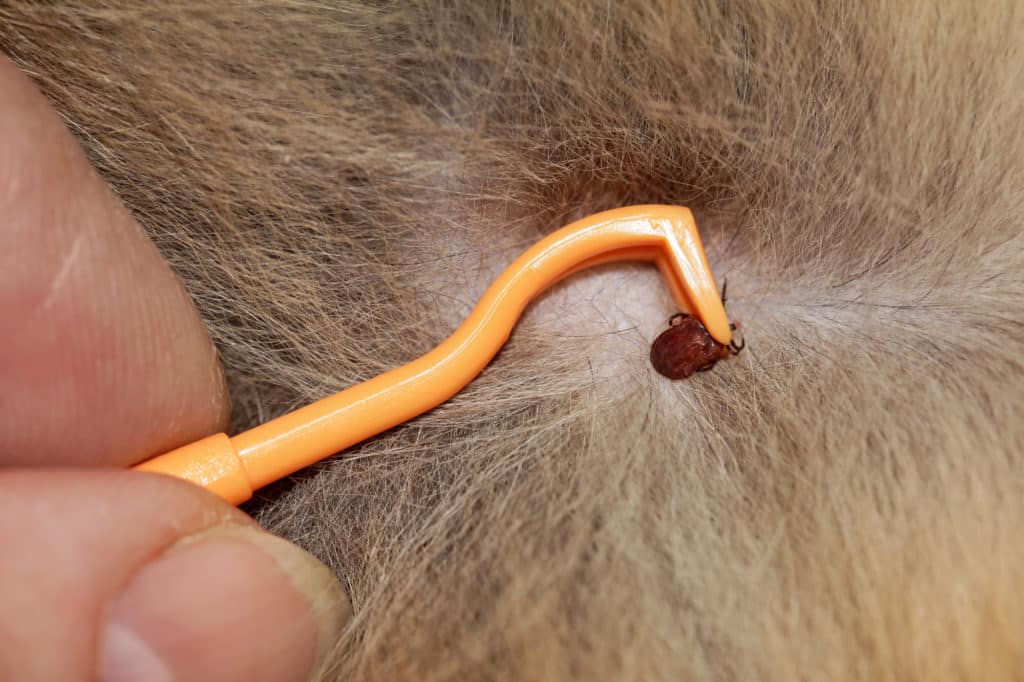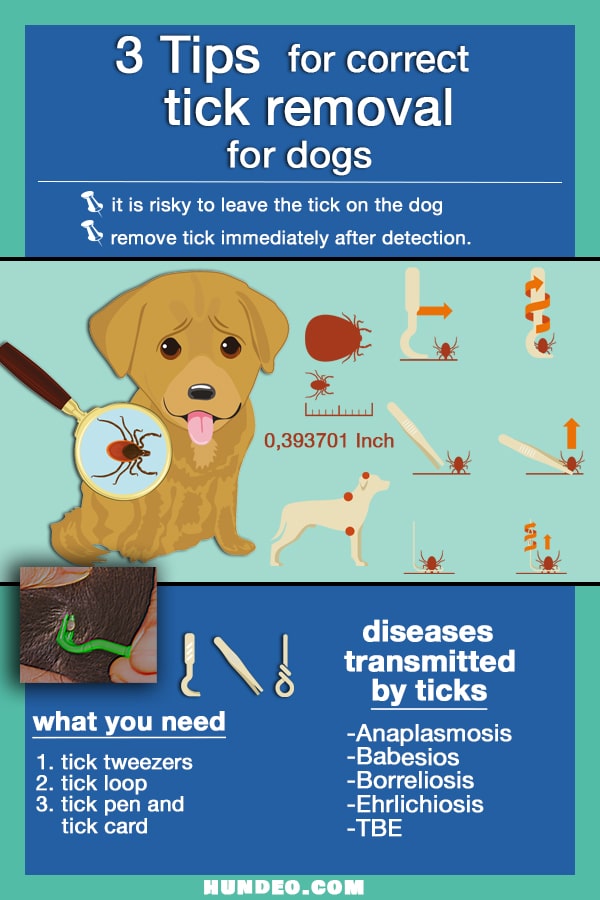Remove ticks from the dog? (This is the right way)
- Veterinarian Mag.med.vet. Emin Jasarevic
- Updated: 2023-04-11
Your dog has a tick? Then you should act quickly! Because ticks like to target dogs. With this guide you will learn how to remove ticks from your pet properly. In addition, we have for this article Advice from veterinarian Mag.med.vet. Emin Jasarevic obtained. So be curious.

You should at least know how to remove ticks properly and what the right tools are.
Can dogs get sick from ticks?
In short, yes. Many diseases can be transmitted by ticks. Often the head of the tick also gets stuck during removal. Thus, can cause a local inflammation at the site of the bite.
It is very risky to let ticks stick to the dog. With each passing hour, the risk of infection from many diseases increases.
This is exactly why you should remove a tick immediately after discovering it. But this must be done correctly.
Incorrect removal can have unpleasant consequences, because if the head gets stuck, then the vet has to remove it with a scalpel.
This may cause pain to your charge or may even need to be done under mild sedation. If the head of the tick is not removed, a local purulent infection may occur.
Why you should learn the right way to remove ticks
At the beginning of our article we had already clarified why it is so important to completely and properly remove a tick immediately after its discovery.
The main reason is that with every hour that passes, the ticks get a better opportunity to infect your pet with diseases. What diseases can be, you will learn now:
- Anaplasmosis
- Babesiosis
- Lyme disease
- Ehrlichiosis
- Early summer meningoencephalitis (TBE)
Important note!
Please note that you must never use tools such as oil, adhesives or similar to anesthetize or kill a tick.
This is because it is precisely then that ticks bring possible pathogens into the wound in larger quantities through increased saliva production.
If you do not feel confident to remove a tick yourself, we advise you to leave this to your veterinarian. He can also show you how you should proceed the next time.
How to remove a tick correctly?

On the market there are various tools and items that will allow you to easily remove the ticks from your four-legged friend.
The most popular tools for tick removal in dogs are the Tick Pliers, the Tick loop and the Tick pen - respectively - the Tick card.
1. tick pliers
Tick nippers are the first choice of most dog owners as a tool for tick removal.
The use of the tick tongs promises an easy and low-risk tick removal. So that you use this tool correctly, we give you here a brief guide:
- Search your dog's fur for ticks
- After you discover a tick, you take the pliers in hand
- Part the fur so that the tick is exposed
- Put your thumb on the button with which you can open the pliers
- Enclose the tick with the forceps and make sure you get as close to the skin as possible
- Release the button to close the pliers
- Turn your hand and the pliers to the left or to the right and thus pull the tick out of your quadruped's skin. The direction in which you turn the tongs and thus the tick is not decisive. The twisting motion loosens the mouthparts and thus pulling the tick out is much easier.
2. tick loop
The tick loop is also increasingly used by dog owners. The process here is almost the same as with the tick pliers.
In pet stores you can get the best advice about the option "tick snare" and decide for or against it.
Here, too, we do not want to deprive you of a brief guide to tick removal:
- If the loop is not loosened yet, do it in the first step
- Part the fur so you have the best possible view of the tick
- Put the loose loop around the tick
- Try to get as close as possible to your dog's skin
- Close the loop
- Pull the tick vertically out of your dog's skin with the tick loop
3. tick pen and tick card
The tick pen and tick card are also successful tools when it comes to properly removing ticks from your dog.
Besides the tick snare, the product is also easy to carry, so you'll be able to get rid of ticks on the go.
Instructions on how to best use the tick pen - or rather - the tick card can be found here:
- Locate tick
- Split the fur so that you have a clear view of the tick as possible
- Slide tool along the skin and clamp under the tick
- Carefully push the tick pen or tick card until you have removed the tick.
The aftercare

Once you have successfully removed the tick from your pet's skin, it is of course still recommended that you apply appropriate aftercare to prevent the area from becoming infected.
The best thing you can do for aftercare is to use the Disinfection. With the right disinfectant you can treat the site of the tick bite permanently.
You should keep a closer eye on your pet for a few weeks after the tick bite. He may have contracted diseases from the sting.
In case of symptoms such as fever, diarrhea, vomiting, discolored urine, listlessness, etc., we recommend to consult the veterinarian immediately.
Frequently Asked Questions
Yes, many diseases can be transmitted by ticks. Often the head of the tick also gets stuck during removal. Thus, a local inflammation can occur at the bite site.
It is best to use a tool that serves only this purpose. If done correctly, you should be able to remove the tick along with its head. For detailed instructions, read our article.
Full ticks can fall off your dog in your home and then come after you. Therefore, be sure to check your dog for ticks and remove them.
Use only tick nippers, tick cards or tick snares. Never use oil or other chemicals, as this will increase the tick's salivation and make infection with a disease more likely.
You should disinfect the sting and observe your dog for a few weeks. He may have contracted diseases from the sting. If he shows symptoms of disease, then visit your veterinarian.
Our experience
Ticks are not only a threat to us humans. They are also a dangerous carrier of diseases for animals. Especially our beloved fur noses suffer from the annual tick plague.
However, this does not mean that you have to accept this plague. Just follow our instructions and nothing will stand in the way of proper tick removal.
Another tip:
There are numerous products on the market for the removal of ticks. As a dog owner, you can quickly lose the overview.
Therefore, we reveal to you our top recommendation. This stainless steel set of 3 is ideal for any type of tick.
Veterinarian’s Recommendation
Ticks are carriers of dangerous diseases! How to prevent them and protect your dog and cat from ticks, you will learn in this video.
PLUS: Step by step guide on how to remove a tick easily and correctly.

I am a veterinarian and writer on animal health topics. Animals are my passion, and it is my personal goal to create medically accurate articles and videos to educate pet owners as much as possible.
Share Now:

